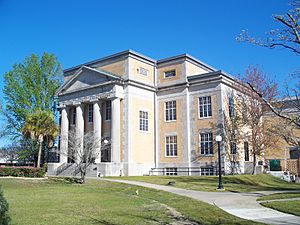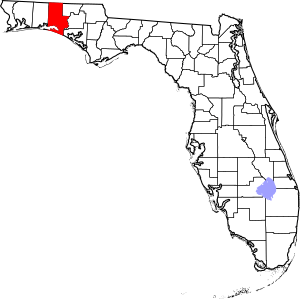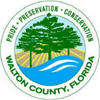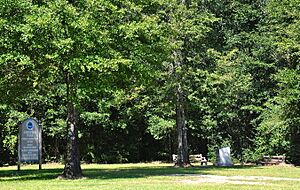Walton County, Florida facts for kids
Quick facts for kids
Walton County
|
|||
|---|---|---|---|

Walton County Courthouse
|
|||
|
|||

Location within the U.S. state of Florida
|
|||
 Florida's location within the U.S. |
|||
| Country | |||
| State | |||
| Founded | December 29, 1824 | ||
| Named for | George Walton Jr. | ||
| Seat | DeFuniak Springs | ||
| Largest community | Miramar Beach | ||
| Area | |||
| • Total | 1,240 sq mi (3,200 km2) | ||
| • Land | 1,038 sq mi (2,690 km2) | ||
| • Water | 202 sq mi (520 km2) 16.3%% | ||
| Population
(2020)
|
|||
| • Total | 75,305 | ||
| • Estimate
(2023)
|
86,354 |
||
| • Density | 60.73/sq mi (23.45/km2) | ||
| Time zone | UTC−6 (Central) | ||
| • Summer (DST) | UTC−5 (CDT) | ||
| Congressional districts | 1st, 2nd | ||
Walton County is a county located in the northwestern part of Florida. It sits on the beautiful Emerald Coast and has its southern edge along the Gulf of Mexico. In 2020, about 75,305 people lived here. The main town, or county seat, is DeFuniak Springs.
Walton County is special because it's home to Britton Hill. This is the highest natural point in Florida, standing at about 345 feet (105 meters) tall. The county is also part of the larger Crestview–Fort Walton Beach–Destin region.
Contents
History of Walton County
Walton County was officially created in 1824. It was named after Colonel George Walton Jr. He was an important person who served as the secretary of the Florida Territory from 1821 to 1826. His father, George Walton, was famous for signing the Declaration of Independence.
Between 1763 and 1783, the area that is now Walton County was part of a British colony called British West Florida. During this time, British settlers made their homes here. They were the first English-speaking people to live permanently in this area.
Scottish settlers came from the Carolinas and settled near what is now DeFuniak Springs. English settlers, many of whom were farmers or fishermen, moved to the southern part of the county by the sea. They settled in places like Santa Rosa Beach and Miramar Beach.
These early communities were mostly self-sufficient. This means they made almost everything they needed themselves. They didn't rely much on trade with outside areas. The only trade was usually between the Scottish settlers in the north and the English settlers by the coast.
The first settlements were in the Euchee Valley. This was near a river landing managed by a person named Sam Story. He was part Yuchi (a Native American group) and part Scottish. The white settlers also started one of the first Presbyterian churches in Northwest Florida. This church still operates today and has a historic cemetery.
When Spain took control of Florida again in 1783, many British settlers left other parts of Florida. However, the English and Scottish settlers in Walton County stayed. The Spanish found them "stubborn" because they wouldn't follow Spanish laws. For example, they refused to become Catholic, even though Spanish law required it. They also wouldn't pay taxes to the Spanish government.
As settlers from the new United States of America moved into north Florida, the English and Scottish communities slowly joined this larger group. This new group eventually became the main population in North Florida.
During the American Civil War, in 1860, about 573 men in Walton County were old enough to serve in the military. About 62 of them, or 11%, joined the Union army. The first monument in Florida to honor Confederate soldiers is at the Walton County Courthouse. It lists the names of 94 soldiers who died fighting for the Confederacy.
In 1995, three special communities were started in Walton County. These were Alys Beach, Seaside, and Rosemary Beach. They are examples of a design style called New Urbanism. This style focuses on creating walkable neighborhoods with homes, shops, and workplaces close together. The plan for Seaside was finished around 1985.
Seaside became famous when it was used as the main filming location for the 1998 movie The Truman Show.
Geography
Walton County covers a total area of about 1,240 square miles (3,200 square kilometers). About 1,038 square miles (2,690 square kilometers) of this is land, and 202 square miles (520 square kilometers) is water. This means about 16.3% of the county is covered by water.
Walton County is the 12th largest county in Florida by area. It stretches from the border with Alabama all the way down to the beautiful Emerald Coast on the Gulf of Mexico.
Neighboring Counties
Walton County shares its borders with several other counties:
- Covington County, Alabama – to the northwest
- Geneva County, Alabama – to the northeast
- Holmes County – to the east
- Washington County – to the east
- Bay County – to the southeast
- Okaloosa County – to the west
Protected Natural Areas
Parts of these important natural areas are located in Walton County:
- Choctawhatchee National Forest
- Point Washington State Forest
Population Information
| Historical population | |||
|---|---|---|---|
| Census | Pop. | %± | |
| 1830 | 1,207 | — | |
| 1840 | 1,461 | 21.0% | |
| 1850 | 1,817 | 24.4% | |
| 1860 | 3,037 | 67.1% | |
| 1870 | 3,041 | 0.1% | |
| 1880 | 4,201 | 38.1% | |
| 1890 | 4,816 | 14.6% | |
| 1900 | 9,346 | 94.1% | |
| 1910 | 16,460 | 76.1% | |
| 1920 | 12,119 | −26.4% | |
| 1930 | 14,576 | 20.3% | |
| 1940 | 14,246 | −2.3% | |
| 1950 | 14,725 | 3.4% | |
| 1960 | 15,576 | 5.8% | |
| 1970 | 16,087 | 3.3% | |
| 1980 | 21,300 | 32.4% | |
| 1990 | 27,760 | 30.3% | |
| 2000 | 40,601 | 46.3% | |
| 2010 | 55,043 | 35.6% | |
| 2020 | 75,305 | 36.8% | |
| 2023 (est.) | 86,354 | 56.9% | |
| U.S. Decennial Census 1790-1960 1900-1990 1990-2000 2010-2015 2019 2020 |
|||
| Race | Pop 2010 | Pop 2020 | % 2010 | % 2020 |
|---|---|---|---|---|
| White (NH) | 46,857 | 60,644 | 85.13% | 80.53% |
| Black or African American (NH) | 3,147 | 3,294 | 5.72% | 4.37% |
| Native American or Alaska Native (NH) | 463 | 415 | 0.84% | 0.55% |
| Asian (NH) | 491 | 907 | 0.89% | 1.2% |
| Pacific Islander (NH) | 37 | 38 | 0.07% | 0.05% |
| Some Other Race (NH) | 62 | 307 | 0.11% | 0.41% |
| Mixed/Multi-Racial (NH) | 1,065 | 3,513 | 1.93% | 4.67% |
| Hispanic or Latino | 2,921 | 6,187 | 5.31% | 8.22% |
| Total | 55,043 | 75,305 | 100.00% | 100.00% |
As of the 2020 United States census, there were 75,305 people living in Walton County. There were 28,635 households and 20,034 families.
Libraries
Walton County has four library branches where you can find books and resources:
- Coastal Branch Library
- DeFuniak Springs Library (this one is historic!)
- Freeport Library
- Gladys N. Milton Memorial Library
Schools
The schools in Walton County are managed by the Walton County School District.
Elementary Schools
- Bay School, Santa Rosa Beach
- Dune Lakes Elementary, Santa Rosa Beach
- Freeport Elementary, Freeport
- Maude Saunders Elementary School, DeFuniak Springs
- Mossy Head Elementary, Mossy Head
- Van R. Butler Elementary, Santa Rosa Beach
- West DeFuniak Elementary, DeFuniak Springs
Middle Schools
- Emerald Coast Middle School, Santa Rosa Beach
- Freeport Middle School, Freeport
- Walton Middle School, DeFuniak Springs
High Schools
- Freeport High School, Freeport
- South Walton High School, Santa Rosa Beach
- Walton High School, DeFuniak Springs
K–12 Schools
- Paxton School, Paxton (serves all grades from kindergarten to 12th)
Charter Schools
- Walton Academy, DeFuniak Springs
- Seaside Neighborhood School, Seaside
- Seacoast Collegiate High School, Seaside
Communities
Cities
Town
Census-Designated Place (CDP)
Other Communities
- Alys Beach
- Argyle
- Blue Mountain Beach
- Bruce
- Darlington
- Eucheanna (Euchee Valley)
- Glendale
- Grayton Beach
- Inlet Beach
- Liberty
- Mossy Head
- Red Bay
- Rosemary Beach
- Santa Rosa Beach
- Seacrest
- Seagrove Beach
- Seaside
- Villa Tasso
- WaterColor
- Rock Hill
Gallery
Transportation
Airports
- DeFuniak Springs Airport
Major Highways
 I-10 (Interstate 10)
I-10 (Interstate 10) US 90 (U.S. Highway 90)
US 90 (U.S. Highway 90) US 98 (U.S. Highway 98)
US 98 (U.S. Highway 98) US 331 (U.S. Highway 331)
US 331 (U.S. Highway 331) SR 20
SR 20 SR 30A
SR 30A SR 81
SR 81 SR 83
SR 83
Notable People
Some well-known people from Walton County include:
- Sean Dietrich, a writer
- Buck Showalter, a baseball manager
See also
 In Spanish: Condado de Walton (Florida) para niños
In Spanish: Condado de Walton (Florida) para niños








